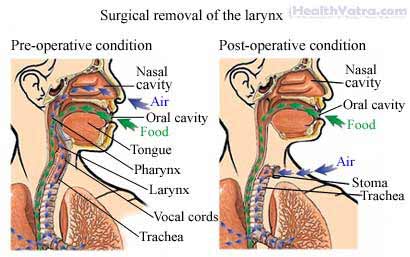تعريف
This is surgery to remove the larynx (voice box). This is usually done to treat cancer. Depending on the extent of the cancer, a partial laryngectomy may be possible.

أسباب هذا الإجراء
Laryngectomy is done to treat cancer of the larynx. This surgery may also be done to treat damage of the larynx due to trauma.
المضاعفات المحتملة
If you are planning to have laryngectomy, your سيقوم الطبيب بمراجعة القائمة من المضاعفات المحتملة، والتي قد تشمل:
- العدوى
- صعوبات في التنفس
- تورم أو نزيف مفرط
- Injury to the trachea (windpipe) or esophagus
- Blood clots
- المشاكل المتعلقة بالتخدير
- Saliva leaking out to the skin (saliva fistula)
- Inability to speak or aphonia
- Cancer occurs again
بعض العوامل التي قد تزيد من خطر المضاعفات تشمل:
- Pre-existing حالة طبية
- سن متقدم
- السمنة
- التدخين
- Previous surgical procedure to the larynx
- Prior radiation or chemotherapy
- سوء التغذية
- مرض السكري
تأكد من مناقشة هذه المخاطر مع طبيبك قبل الجراحة.
ما يمكن توقعه
قبل الإجراء
قد يقوم طبيبك بما يلي:
- اختبار بدني
- Laryngoscopy —the use of a long, thin, lighted tube (laryngoscope) to examine the larynx
- Radiation therapy—to treat cancer
Leading up to your surgery:
- التحدث مع طبيبك عن الأدوية الخاصة بك. قد يطلب منك التوقف عن تناول بعض الأدوية تصل إلى أسبوع واحد قبل العملية مثل:
- الأدوية المضادة للالتهابات (مثل الأسبرين)
- Blood thinners, like clopidogrel (Plavix) or warfarin (Coumadin)
- Also talk to your doctor about ways to restore speech, such as:
- Tracheoesophageal puncture
- Hand-held speech aids
- تناول وجبة خفيفة في الليلة السابقة للجراحة. لا تأكل أو تشرب أي شيء بعد منتصف الليل.
التخدير
General anesthesia will be used. It will block any pain and keep you asleep through the surgery. It is given through an IV in your hand or arm.
وصف الإجراء
The doctor will make a cut in the skin on your neck. He will divide the muscles that are attached to the larynx. The larynx and surrounding tissue will then be removed. Sometimes, a partial laryngectomy will be done. In this case, the doctor will remove the tumor and only part of the larynx. If you have this نوع الجراحة, you may retain some normal speech and more of your normal swallowing function.
A stoma (hole) will be created through the skin in the neck. Next, the trachea will be connected to the opening. This will enable you to breathe through the hole. In some cases, the doctor will insert a tracheostomy tube. This tube, which fits into the stoma, will act as an airway, helping you to breathe. The doctor will insert drainage tubes to drain blood and fluid. Lastly, the muscles and skin will be brought together and closed with stitches or clips.
كم من الوقت سيستغرق ؟
5-9 hours
كم هو مؤلم ؟
You will have pain while recovering, but your doctor will give you pain medicine.
متوسط الإقامة في المستشفى
هذا surgery is done in a hospital setting. The usual length of stay is 7-14 days. Your doctor may choose to keep you longer if complications arise.
رعاية ما بعد العملية
في المستشفى
While you are recovering at the hospital, you will:
- Have an oxygen mask over the stoma.
- Be given nutrition through an IV tube in your vein or a feeding tube. A speech pathologist or doctor will assess your ability to swallow. Depending on the results, you will progress to soft foods.
- You may also need to wear boots or special socks to help prevent blood clot formation in your legs
- Be instructed to:
- Use a call bell and message board to communicate.
- Keep the head of your bed raised.
- Move your legs while in bed to increase circulation.
- Learn to care for your stoma and tracheostomy tube, which includes:
- Using a mist hood over the stoma
- Keeping water out of the stoma
- Covering the stoma with a shower hood when showering
- Suctioning secretions
- Have the drains removed in about five days. The stitches will be removed in about one week.
في البيت
When you return home, do the following to help ensure a smooth recovery:
- تأكد من اتباع تعليمات طبيبك.
- For about six weeks, avoid lifting heavy objects and doing strenuous activity.
- Participate in a speech rehabilitation program. You will need to learn how to speak again. The program may involve speaking by:
- Swallowing air and expelling it (esophageal speech)
- Using an electronic device (artificial larynx)
- Installing a valve in the stoma to allow air from the lungs to reach the esophagus (tracheoesophageal speech)
The throat tissue will heal in about 2-3 weeks. Complete recovery will take about a month. You may notice a reduction in your sense of taste and smell. You will continue to use the stoma for breathing.
Most patients are able to return to their jobs and past activities, except for swimming. Ask your doctor about when it is safe to shower, bathe, or soak in water.
Joining a support group may help you to cope with the surgery.
استدعاء الطبيب
بعد مغادرة المستشفى، اتصل بطبيبك في حالة حدوث أي مما يلي:
- علامات الإصابة, بما في ذلك حمى وقشعريرة
- احمرار أو تورم أو ألم متزايد أو نزيف شديد أو أي إفرازات من موقع الشق
- الغثيان و / أو القيء الذي لا يمكنك السيطرة عليه بالأدوية التي أعطيت لك بعد الجراحة ، أو التي تستمر لأكثر من يومين بعد الخروج من المستشفى
- ألم لا يمكنك السيطرة عليه بالأدوية التي أعطيت لك
- سعال أو ضيق في التنفس أو ألم في الصدر
- Headache, muscle aches, or dizziness
- Tracheostoma is getting smaller
- Saliva leaking through your incision
- أعراض جديدة غير مبررة
في حالة الطوارئ ، اتصل على المساعدة الطبية على الفور.
